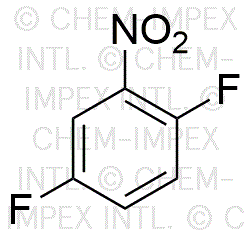2,5-Difluoronitrobenzene is widely utilized in research focused on:
- Pharmaceutical Development: This compound serves as an important intermediate in the synthesis of various pharmaceuticals, particularly those targeting specific biological pathways. Its unique fluorine substitution enhances the bioactivity of drug candidates.
- Material Science: It is used in the development of advanced materials, including polymers and coatings. The fluorine atoms improve chemical resistance and thermal stability, making it suitable for high-performance applications.
- Agricultural Chemicals: 2,5-Difluoronitrobenzene is involved in the formulation of agrochemicals, including pesticides and herbicides. Its properties help in enhancing the efficacy of these products while minimizing environmental impact.
- Analytical Chemistry: This compound is utilized as a reagent in analytical methods, such as chromatography and mass spectrometry. Its distinct characteristics allow for improved detection and quantification of various substances.
- Research in Organic Synthesis: It plays a crucial role in organic synthesis, particularly in the development of new synthetic pathways. Researchers leverage its reactivity to create complex molecules with high precision.
General Information
Properties
Safety and Regulations
Applications
2,5-Difluoronitrobenzene is widely utilized in research focused on:
- Pharmaceutical Development: This compound serves as an important intermediate in the synthesis of various pharmaceuticals, particularly those targeting specific biological pathways. Its unique fluorine substitution enhances the bioactivity of drug candidates.
- Material Science: It is used in the development of advanced materials, including polymers and coatings. The fluorine atoms improve chemical resistance and thermal stability, making it suitable for high-performance applications.
- Agricultural Chemicals: 2,5-Difluoronitrobenzene is involved in the formulation of agrochemicals, including pesticides and herbicides. Its properties help in enhancing the efficacy of these products while minimizing environmental impact.
- Analytical Chemistry: This compound is utilized as a reagent in analytical methods, such as chromatography and mass spectrometry. Its distinct characteristics allow for improved detection and quantification of various substances.
- Research in Organic Synthesis: It plays a crucial role in organic synthesis, particularly in the development of new synthetic pathways. Researchers leverage its reactivity to create complex molecules with high precision.
Documents
Safety Data Sheets (SDS)
The SDS provides comprehensive safety information on handling, storage, and disposal of the product.
Product Specification (PS)
The PS provides a comprehensive breakdown of the product’s properties, including chemical composition, physical state, purity, and storage requirements. It also details acceptable quality ranges and the product's intended applications.
Certificates of Analysis (COA)
Search for Certificates of Analysis (COA) by entering the products Lot Number. Lot and Batch Numbers can be found on a product’s label following the words ‘Lot’ or ‘Batch’.
Numéro de catalogue
Numéro de lot/série
Certificates Of Origin (COO)
This COO confirms the country where the product was manufactured, and also details the materials and components used in it and whether it is derived from natural, synthetic, or other specific sources. This certificate may be required for customs, trade, and regulatory compliance.
Numéro de catalogue
Numéro de lot/série
Safety Data Sheets (SDS)
The SDS provides comprehensive safety information on handling, storage, and disposal of the product.
DownloadProduct Specification (PS)
The PS provides a comprehensive breakdown of the product’s properties, including chemical composition, physical state, purity, and storage requirements. It also details acceptable quality ranges and the product's intended applications.
DownloadCertificates of Analysis (COA)
Search for Certificates of Analysis (COA) by entering the products Lot Number. Lot and Batch Numbers can be found on a product’s label following the words ‘Lot’ or ‘Batch’.
Numéro de catalogue
Numéro de lot/série
Certificates Of Origin (COO)
This COO confirms the country where the product was manufactured, and also details the materials and components used in it and whether it is derived from natural, synthetic, or other specific sources. This certificate may be required for customs, trade, and regulatory compliance.


